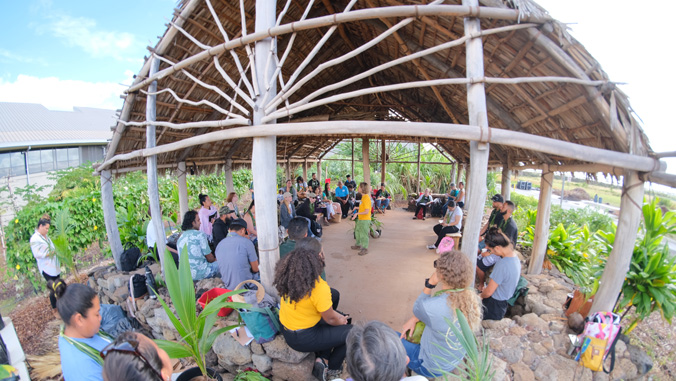
Nearly 200 community members, scientists, cultural practitioners, storytellers and colleagues gathered January 10, at the University of Hawaiʻi–West Oʻahu to honor the land—the way it educates, inspires and instructs—at the third annual ʻAha ʻĀina Aloha event.
Coordinator Manulani Aluli-Meyer, director of UH West Oʻahu indigenous education and, Konohiki (head) of Kūlana o Kapolei, noted the event was not a conference, but an ʻaha—a capacity to meet, to befriend people.
“We are working across program lines, objective lines, to find each other as friends,” said Aluli-Meyer. “We are linking people who have an awareness that our lands have always loved us. So whether we’re an archaeologist, or whether we’re an educator, or whether we’re a developer of a mass transit system, we are meeting each other across those lines to see each other’s excellence.”
The day began with guests being greeted with ti leaf lei provided by the UH West Oʻahu Aloha ʻĀina Student Service Club and the singing of “Mele Honouliuli” by UH West Oʻahu faculty and staff.
“Those of us who gathered here, gathered here because we love the land,” UH West Oʻahu resident kupuna Aunty Lynette Kaopuiki Paglinawan said in her welcome remarks.
UH West Oʻahu Chancellor Maenette Benham welcomed attendees and shared a cherished memory of spending time as a little girl with her grandfather, a fisherman, in Kaʻaʻawa.
“We have to remember that today, as you go through all of your different panels, presentations and conversations, is that feeling—that kanaka ʻāina connection of feeling the embrace of this place that is part of all our DNA—is so very important to all of us…to the many generations to come,” Benham said.
Rail update
Among the first guest speakers was Andrew Robbins, CEO of HART, who provided an update on the rail project.
“(We are) going to be connecting most of the major campuses across the island, right here with our Keoneʻae Station that you can see off in the distance, (including) Leeward Community College, Honolulu Community College (and eventually) UH Mānoa,” Robbins shared. “So just think about that: students, faculty can transfer very quickly and seamlessly between campuses.”
In addition to providing mobility with the rail, “we also hope to contribute to telling the story of the host culture here,” Robbins emphasized, highlighting features such as Hawaiian station names and interpretive signage at every station.
For more details, visit E Kamakani Hou.
—By Zenaida Serrano Arvman

